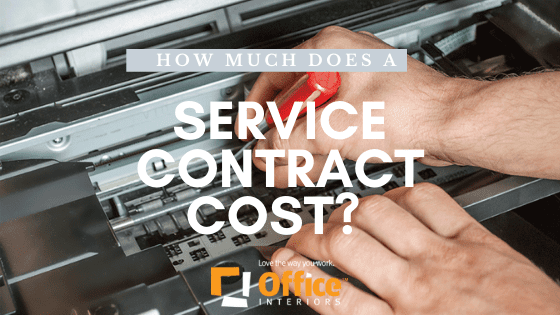The vast majority of our office equipment customers elect to purchase a service contract when buying or leasing a new copier or printer with us. However, we’ve noticed that unless someone is an experienced purchaser of office equipment, there can be a lot of confusion about how a service contract is priced.
Since the actual dollar value of a service is dependent on the device the service contract is for, I won’t be able to give a definitive price that you should expect. Instead, in this post, I plan on shedding some light on how copier and printer service contracts are priced and billed so that you can better understand where that number comes from and what factors will impact it.
We won’t be digging into what a service contract is or why you have one as we recently wrote another article on that very topic, What Does a Service Contract Cover?
What is Included in a Service Contract?
A service contract will typically cover anything that is directly related to the device itself but not the network in which it operates. The minimum industry standard benefits covered by a service contract are breakdown/quality issues and subsequent parts and labour, as well as priority service over clients without a service contract.
Most service contracts these days will also include all your toner and preventative maintenance parts and labour.
Another very valuable benefit that is provided by some dealers is the complimentary use of a loaner unit if your device cannot be immediately repaired; however, this isn’t an industry standard, and you should always check with the dealership if they offer this service before signing a service contract.
A few important notes to keep in mind are what is not covered by a service contract. Specifically, anything that might cause a device to function poorly (or not at all) but is not a fault of the device itself.
Continuing with our car metaphor again, even the best bumper-to-bumper warranty won’t extend beyond the car itself… and neither will a service contract.
Just like your car warranty doesn’t cover if you accidentally drive your car into a light post, a service contract is unlikely to foot the bill to repair your device if the malfunction is directly caused by something someone at your organization did to the device (or the network it uses).
From our own experience, we find that changes to the network or firewall are one of the most common causes of connectivity issues with a copier/printer that is not covered by a service contract.
How is a Service Contract Priced and Billed?
Service contracts are billed on a Cost Per Click (CPC) basis. Monochrome (B&W) and colour impressions (copies/prints) are each billed at a different CPC rate. Generally, your dealership will bill you quarterly for the combined impressions accrued during the previous quarter, but some contracts can be configured where you pre-purchase “blocks” of impressions.
It should also be mentioned that most contracts will charge for billable time and any non-contract service that is requested.
Your quarterly bill is determined by taking a “meter reading” from your device. Much like the water or power meter on your home, your copier or printer will track the lifetime count of impressions printed or copied. By comparing your previous quarter’s reading to your current reading, your dealership can bill you for the correct number of monochrome and colour impressions.
Meter readings can be taken in a number of ways but the most common methods are:
- An A/R person from the dealership will call and ask you to manually take the meter reading from your device
- Your dealership will provide you with a form to complete and submit each quarter
- The dealer installs software on your network that will automatically collect and submit the meter readings to the dealership
The industry standard is to base the CPC rates on a Service Costing Document released by each of the major office equipment manufacturers. Unfortunately, this means that the dealership with which you are signing the service contract rarely has much influence on the actual CPC rate which they are quoting you.
This Costing Document factors in the estimated parts, labour, and toner usage for each particular device model. As your device ages or its lifetime impression count rises, the manufacturers estimate that a device will require more frequent servicing and parts may become more difficult to acquire. This is why you will often see a service contract increase in price each year upon renewal.
Can You Cancel or End a Service Contract?
The short answer to this is yes, but there are a few caveats. Most service contracts contain a cancellation policy that allows either the dealer or the customer to end the contract provided they give written notice 30 days in advance.
You may begin to run into issues if you lease rather than outright own your device. In this case, the leasing contract (which is usually with a third-party leasing company rather than the dealer itself) often includes a stipulation that the device is regularly serviced and kept in proper operating condition.
Many leasing contracts may even explicitly state that a service contract must be in place for the device. Even if your lease doesn’t mandate a service contract, it can be rather risky to forgo the service contract on a leased device as the lessor will require the device to be in full working condition upon the expiration of the lease. No one wants to get hit with a repair bill on a device after their lease expires.
Have More Questions?
Hopefully, after reading this article, you feel a little more confident going into your next contract negotiations. If, however, you still have questions we are here to help! Just submit your question on our contact form and one of our team will get back to you with an answer. It’s as simple as that.
Cory Porteous
Director of Marketing & Inbound Business Development
Office Interiors




